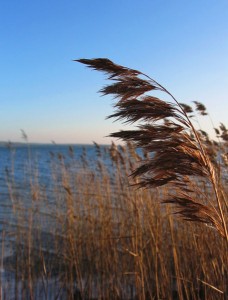
Phragmites australis
In order to help restore and sustain the tidal wetlands along the lower Connecticut River, The Nature Conservancy last year undertook invasive phragmites control work at 12 locations on more than 215 acres, including sites in both Lyme and Old Lyme.
Paid for by funding provided by the Ecosystem Management and Habitat Restoration grants administered by the Connecticut Department of Energy and Environmental Protection (DEEP), the state-permitted and safe herbicide treatments are necessary to help sustain the gains made by DEEP, The Nature Conservancy and others against phragmites.
Initial post-treatment monitoring concluded in June 2013, and the DEEP grant-funded work completed last year by the Conservancy helps ensure that gains made from previous phragmites control efforts are sustained.
In addition to sustaining gains made against phragmites, the project provides more experience and know-how for partners to better analyze best management practices, ensuring future decisions remain well informed.
Apart from Lyme and Old Lyme, the treatments took place at sites in Essex, East Haddam and Old Saybrook. Observation of conditions in treated areas will be ongoing.
“The Conservancy is grateful for the DEEP’s leadership on this issue,” said David Gumbart, assistant director of land management for The Nature Conservancy in Connecticut. “We’re also grateful to the many private landowners who granted permission for work on their lands and appreciative of the many supportive local land trusts and towns.”
In the 1990s, a study documenting the invasion of phragmites along the lower Connecticut River showed that the outstanding native biodiversity for which these marshes are famous was disappearing at an alarming rate. In some locations, over 40 percent of the native plant communities had been converted to phragmites in less than 30 years.
Subsequently, the Conservancy, DEEP and others began work to stop these losses and rein in phragmites in the tidal marsh system using conventional herbicide and mulching treatments. Over time, an approximately 80 percent reduction of the plant has been achieved in the tidal marshes of the lower Connecticut River. These efforts also helped regain additional habitat that will see colonization by native species.
More about phragmites and the Lower Connecticut River
Invasive European strains of Phragmites australis were introduced to the United States in the 1880s, possibly through ships’ ballast, according to the United States Department of Agriculture’s National Invasive Species Information Center.
Since then, phragmites has become one of the biggest threats to the lower Connecticut River’s exemplary tidal marsh system. This is because it overruns the native plant communities that are a primary feature in the system’s health and productivity.
Although common birds and wildlife can utilize stands of phragmites, the biodiversity and overall ecological integrity of a marsh system is severely compromised by the invasive plant.
Sustaining the tidal marsh habitats through efforts such as phragmites control sustains rare plant species, as well as the migratory, shore and wading birds that thrive in these habitats. Among the other beneficiaries are fish, including the Atlantic silverside, that utilize the marshes at high tide. Such work also helps sustain the quality of the Long Island Sound.
The Nature Conservancy is the leading conservation organization working around the world to conserve the lands and waters on which all life depends. The Conservancy and its more than 1 million members have protected nearly 120 million acres worldwide. Visit The Nature Conservancy at www.nature.org/connecticut